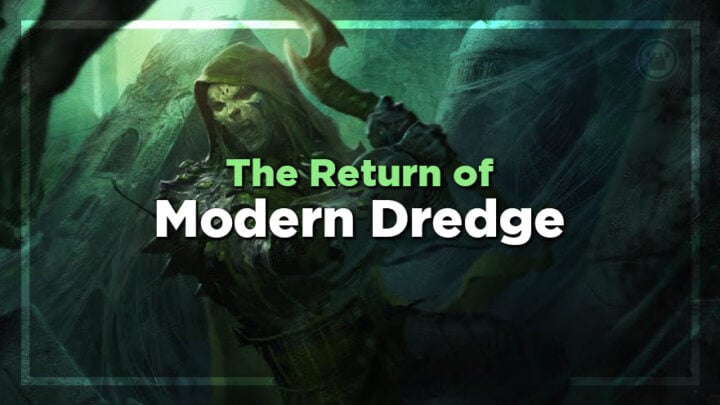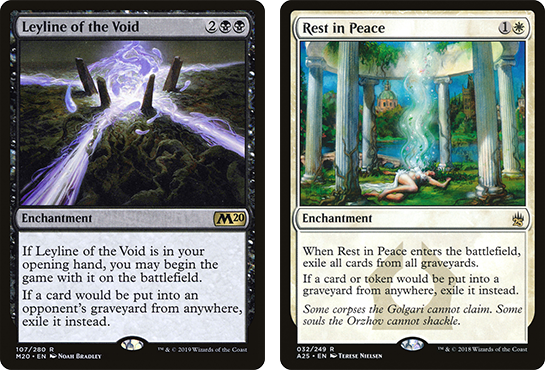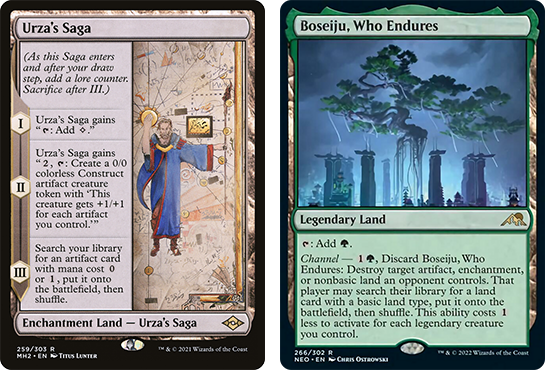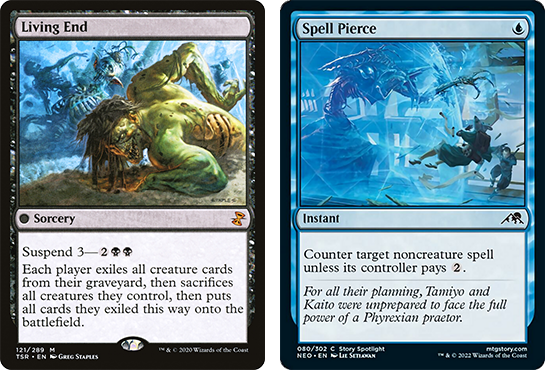Modern Dredge has been dormant for a bit, but Michael thinks the deck is poised for a comeback in the volatile format.
Everyone Forgot About Dre(dge)
Dredge has struggled since the release of Modern Horizons 2, which I use as my benchmark for what I call, “New Modern”. In recent weeks Dredge has started to make a resurgence with a handful of good MTGO challenge finishes, including a recent top 8. Today we’ll be looking at a top 16 list from the Dredge master, Sodeq. This is going to be more than just taking a look at a decklist though, I want to take a closer look at the metagame factors that re-opened the window for Dredge.
What is Dredge?
If you’ve been around Modern for a while you’re probably familiar with how Dredge works, but if you’re unfamiliar it can look quite confusing on the surface. Dredge plays a unique game of Magic compared to traditional decks. The Dredge mechanic gives you the option to replace any cards you would draw by milling the corresponding number of cards from your deck, and returning that card from your graveyard to your hand. For example you may replace your draw step by dredging Stinkweed Imp, by putting the top five cards of your deck into your graveyard and returning Stinkweed Imp from your graveyard to your hand. What does putting a bunch of cards into your graveyard accomplish? Well, Narcomoeba, Silversmote Ghoul, and Prized Amalgam all come back from the graveyard. The core engine of Dredge is Cathartic Reunion and Thrilling Discovery in combination with Stinkweed Imp, Golgari Thug, or Darkblast to flip over huge chunks of your deck. Narcomoeba, Ox of Agonas, and Creeping Chill are the keys to get things going, as they’re going to bring back Silversmote Ghoul and Prized Amalgam to let you put the pressure on the opponent.
Strengths
Dredge is no longer the powerhouse it was when Golgari Grave-Troll and Hogaak, Arisen Necropolis were legal, but it definitely shows up when the time is right. What is Dredge good at? The fairer Modern is, the better Dredge is. Resilience is key, Dredge laughs at decks that try to manage the board with removal spells. Unholy Heat and Fatal Push don’t accomplish much when the things they’re killing are Silversmote Ghoul and Prized Amalgam, which are just going to come back. Creeping Chill is an absolute haymaker against aggressive decks against Burn, so the better those decks are, the better Dredge is.
Weakness
Now that we know where Dredge succeeds, it is only fair that we talk about where it fails. First and foremost, graveyard hate is Dredge’s biggest enemy. Leyline of the Void, Rest in Peace, Surgical Extraction, Relic of Progenitus, Nihil Spellbomb, Soul-Guide Lantern, you name it, if it exiles a graveyard Dredge doesn’t want to see it. Dredge plays differently than a deck like reanimator that cares about putting specific cards in the graveyard, Dredge needs to keep putting cards in their graveyard for the entire game to keep the engine rolling. This means that it is harder for Dredge to overcome being interrupted than other graveyard decks, as it functions as more of a critical mass deck.
Dredge also tends to struggle against combo decks. It is no coincidence that Modern is low on both graveyard hate and combo decks right now, letting Dredge find its way back into the competitive metagame. Dredge simply just isn’t fast enough to keep up with decks like Belcher or Glimpse of Tomorrow, and doesn’t have meaningful ways to interact with those decks. Amulet Titan is perhaps the most threatening combo deck for Dredge to face that is seeing any reasonable amount of play. Amulet can produce some lightning fast kills, but also has access to Bojuka Bog, which they can also pick up with bounce lands to effectively lock Dredge out of the game.
Changing of the Guard
For years permanent based graveyard hate like Leyline of the Void and Rest in Peace were the gold standard of ways to beat graveyard strategies. Thanks to Lurrus of the Dream Den, players moved toward repeatable ways to exile the graveyard, such as Nihil Spellbomb and Soul-Guide Lantern. Now that Lurrus is banned, Urza’s Saga is still pushing players toward one-mana value pieces of hate to tutor.
Boseiju, Who Endures adds a whole new layer to the texture of what kind of graveyard hate is playable in Modern. Due to the prevalence of Boseiju, players are forced to move away from Leyline of the Void, Rest in Peace, and Grafdigger’s Cage because suddenly they’re much more vulnerable than they used to be. This is good for Dredge because you can take things slowly and force the opponent to exile the graveyard with one of the artifacts early, and then rebuild quickly with Cathartic Reunion or Thrilling Discovery.
Is Living End Helping Dredge?
Usually the more popular graveyard decks are overall, the worse off they are. As people play more Living End and Dredge you would expect to see more graveyard hate in sideboards…but we aren’t, and the secret is because of…Rhinos? Normally people would choose to fight Living End with graveyard hate instead of counterspells because of Force of Negation and Mystical Dispute. However, due to the popularity of Rhinos, players are counting on cards like Spell Pierce and Flusterstorm to pull double duty against both cascade decks. Increasing the number of counterspells in sideboards seems to be coming at the cost of graveyard hate.
As we can see, Urza’s Saga, Boseiju, Living End, and Rhinos are coming together to make this perfect storm that creates a world with less and more beatable graveyard hate. Combine that with the rest of Modern being exceptionally fair, this seems like a great weekend to be playing Dredge!
As always, you can find me on Twitter at @RappaciousOne for questions and comments. If you see me in Dallas this weekend please don’t hesitate to say hello! Until next week, remember, don’t forget about Dre(dge).

Michael Rapp is a Modern specialist who favors Thoughtseize decks. Magic sates his desire for competition and constant improvement.







